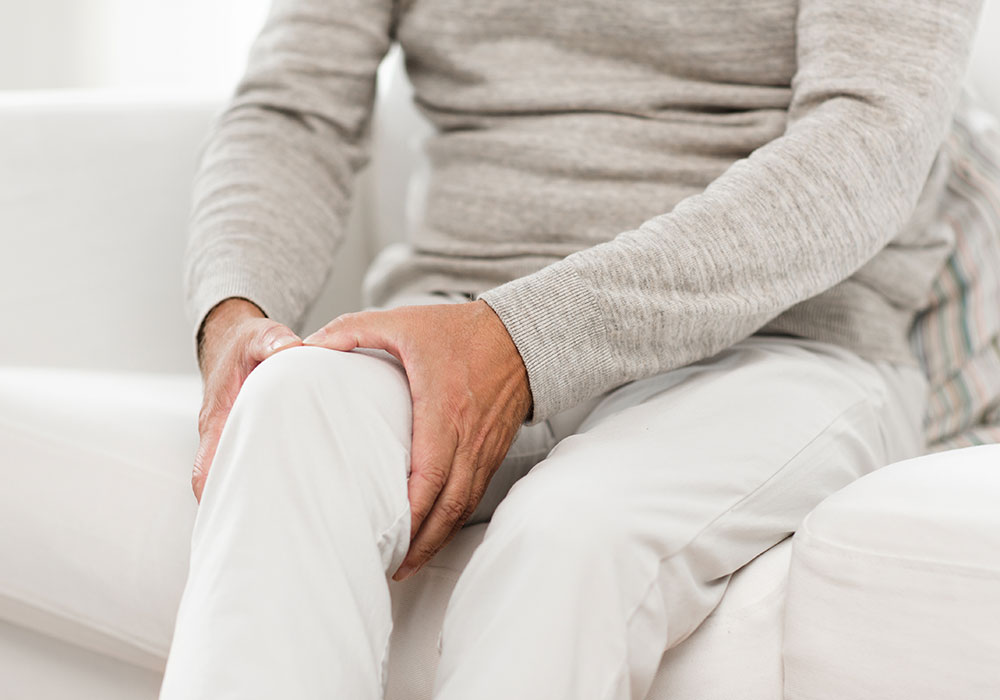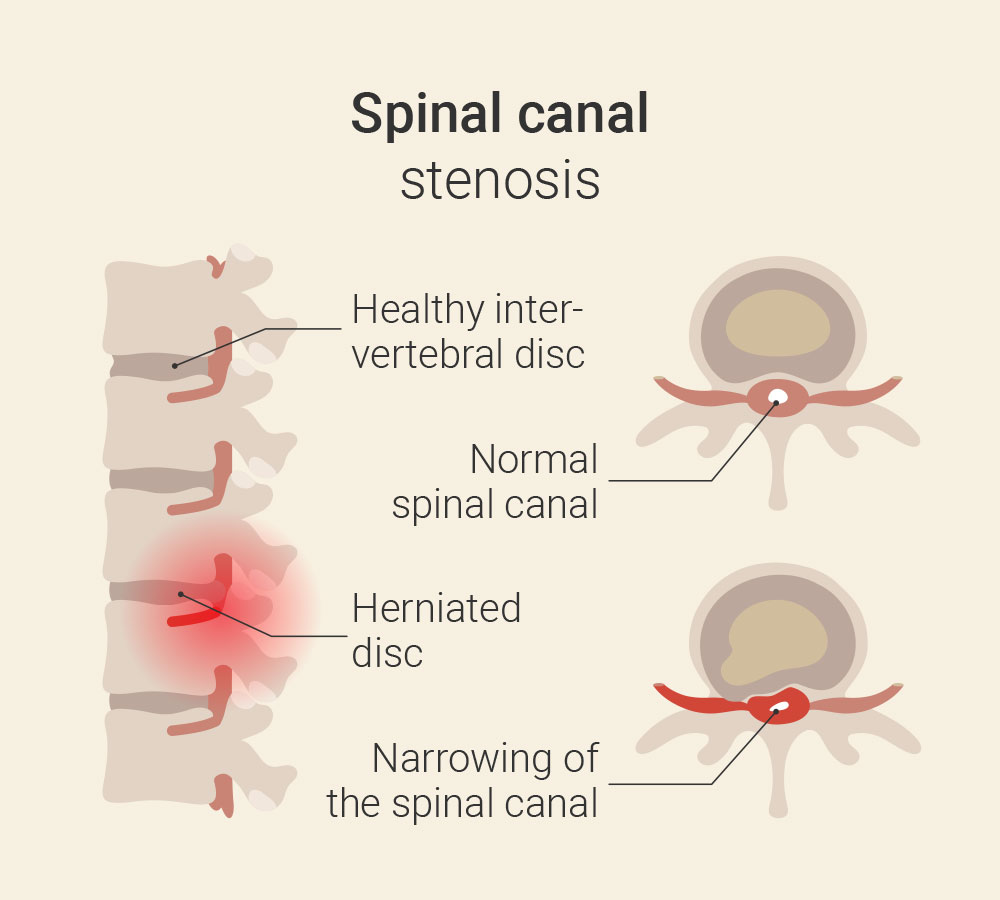Stinging, pulling or burning leg pain – there is often more to it than muscle tension or circulatory problems. If symptoms increase when walking but subside when resting, a narrowing of the spinal canal could be the cause. This so-called spinal canal stenosis presses on the nerves and can cause back pain as well as discomfort and weakness in the legs. In the following, we explain why this happens, what symptoms are typical and what treatment options are available.

What is the spinal canal?
The spinal canal is a bony canal that runs through the entire spinal column and protects the spinal cord and the nerves that emerge from it. It is formed by the vertebral bodies, the vertebral arches and the intervertebral discs between them. The spinal cord (up to about the first or second lumbar vertebra) and the nerve roots, which transmit signals between the brain and body, run within the spinal canal. Among other things, these nerves control movements and sensations in the arms and legs.
What is spinal canal stenosis?
Spinal canal stenosis is a narrowing of the spinal canal that can exert pressure on the spinal cord or the nerves running through it. This narrowing is usually caused by signs of wear and tear in the spine, such as bony growths (spondylosis), herniated discs or thickening of the ligaments in the back. Spinal canal stenosis occurs most frequently in the lumbar spine, as this section of the spine is subject to heavy strain.

Spinal canal stenosis and leg pain: how are they connected?
With spinal canal stenosis, the space in the spinal canal is reduced. This constricts the nerves, which can lead to impaired transmission of stimuli. If the stenosis affects the lumbar spine, the nerve roots that control the legs and feet are affected.
Typical complaints associated with this are
- Pain that increases when walking or standing
- Relief of pain by sitting or leaning forward
- Tingling, numbness or weakness in the legs
- Problems with prolonged walking or climbing stairs
The symptoms can vary depending on the severity of the narrowing.
Diagnosis of spinal canal stenosis with leg pain
Leg pain can have many causes, including circulatory disorders, herniated discs or nerve disorders. If the problems last longer, get worse or are accompanied by numbness, muscle weakness or unsteady gait, it is important to seek medical clarification. An early diagnosis can help to treat symptoms in a targeted manner and avoid long-term restrictions.
At our private practice for orthopaedics and traumatology in Frankfurt, we diagnose spinal canal stenosis in several steps. This allows us to ensure that the leg pain is actually caused by a narrowing of the spinal canal.
- Medical consultation (medical history)
First, we ask you specifically about your symptoms:- Does the pain occur when walking or standing and does it subside when you sit down or bend forward?
- Is there any additional tingling, numbness or muscle weakness in your legs?
- How long have the symptoms persisted?
- Are there any pre-existing conditions such as osteoarthritis or disc problems?
- Physical examination
The next step is to examine your musculoskeletal system.- We check the mobility of your spine.Can you bend forward?
- Does the pain subside in this case?
- We then carry out nerve tests. How are your reflexes, how is the muscle strength and sensitivity of your legs?
- If necessary, we can follow up with walking tests. How well can you walk?
- Imaging procedures
To confirm the diagnosis, we can follow up with various other examination methods:- X-ray
The X-ray examination can provide indications of signs of wear and tear, but does not show any nerves or soft tissue. - MRI
Magnetic resonance imaging shows the narrowing of the spinal canal and whether nerves are trapped. - CT scan
Computed tomography allows a detailed representation of bony changes in the spine.
- X-ray
In some cases, we also perform a diagnostic nerve block. This involves injecting an anesthetic into the affected area. If the pain disappears temporarily, this indicates spinal canal stenosis.
Treatment of leg pain caused by spinal canal stenosis
Treatment for spinal canal stenosis aims to reduce the pressure on the affected nerves and thus alleviate leg pain, numbness or muscle weakness. Depending on the severity, conservative or surgical treatment may be considered.
Conservative treatment at our orthopaedic practice in Frankfurt
We use the following methods as part of spinal therapy, especially for mild to moderate symptoms:
Medication
First of all, we can prescribe non-steroidal anti-inflammatory drugs (NSAIDs) to relieve pain and inflammation. In addition, muscle relaxants can help to relieve tension that may be associated with the stenosis. For more severe nerve pain, nerve medications such as pregabalin or gabapentin are useful.
Injections and minimally invasive procedures
We use so-called spinal infiltrations to inject anti-inflammatory and pain-relieving substances near the affected nerve roots and vertebral joints. This can help to reduce inflammation and relieve pain caused by the narrowing of the spinal canal.
Traction treatments have also proven effective. Using gentle longitudinal traction and the simultaneous application of heat, we relieve pressure on your spine and the surrounding structures. This method can help to reduce the pressure on the nerves and thus alleviate the symptoms of spinal canal stenosis. We can correct misalignments or blockages of the vertebral joints using special chiropractic techniques. This can improve mobility and reduce pressure on the nerves.
Acupuncture can also provide valuable support for leg pain caused by spinal canal stenosis. Although it cannot correct the narrowing of the spinal canal, it relieves pain, relaxes the muscles and promotes blood circulation. The targeted stimulation of certain points releases the body’s own painkillers and reduces inflammatory processes. The procedure can also stabilize nerve function.
Kinesio taping, which we also offer at our practice in Frankfurt, can also have a supportive effect. Taping can support the muscles, relieve tension and promote blood circulation. The elastic tapes reduce pressure on nerves, which can relieve pain and improve mobility.
CT- and MRI-guided infiltrations (periradicular therapy, PRT)
Under imaging control (CT or MRI), we inject an anti-inflammatory medication directly into the irritated nerve roots. This precise method aims to relieve the pressure on the nerves and thus reduce the pain radiating into the leg.
Physiotherapy and physical measures
Targeted exercises to strengthen and stretch the muscles support the stability and flexibility of the spine. Physical therapies such as heat or cold applications can also relieve pain and reduce inflammation.
If conservative therapy is not enough: surgical treatment
If the symptoms increase despite conservative therapy, neurological deficits occur or the walking distance is severely restricted, surgery may be necessary. Possible options here are
Decompression surgery (pressure relief)
Excess tissue or bony growths are removed to relieve pressure on the nerves.
Stiffening surgery (fusion surgery)
If the spine is unstable, spondylodesis (fusion using screws and rods) may also be necessary.
Dynamic stabilization
In some patients, a motion-preserving implant (e.g. interspinous spreader) can be used instead of fusion to keep the spinal canal open.
Leg pain due to spinal canal stenosis: diagnosis and treatment in our practice in Frankfurt
Leg pain caused by spinal canal stenosis can significantly reduce your quality of life. At our practice in Frankfurt, we offer precise diagnostics and individually tailored treatment concepts to specifically alleviate your symptoms. Using modern examination methods, we determine the cause of the pain and develop a customized treatment plan. Our aim is to maintain your mobility and reduce the pressure on the nerves.
Let our experienced team advise you and help you find the best way to improve your mobility and quality of life. Simply contact us to arrange an appointment!
236262208 © Syda Productions | 433581203 © dbayan | stock.adobe.com